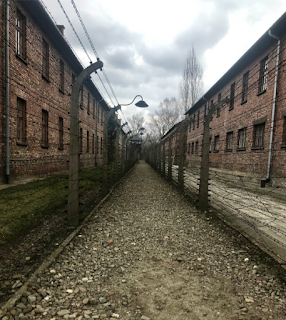I have been in Oswiecim for two full days now. My experience thus far has been overwhelming. My knowledge on Jewish culture, Jewish-Christian relations, as well as the Shoah itself has grown exponentially. On our second day we visited Auschwitz I. When I entered the camp my mind went numb. I think it was then when I saw the infamous sign, “Arbeit Macht Frei,” that I truly realized that I was standing on the world’s largest burial ground. As we walked through the camp Marta, our tour guide, was re-counting the different events that took place in Auschwitz. She took us inside barrack number 11. This barrack was known for its inhumane acts of violence and torture. It contained a dark room, a starvation room , stand up chambers, as well as numerous different torture cells. Marta retold the story of Maximillian Kolbe. Maximillian Kolbe was a Franciscan Friar as well as a prisoner in Auschwitz. In 1941 a prisoner escaped. The SS men have this policy known as “collective responsibility” meaning that if one prisoner escapes ten people will be held responsible for his actions and suffer the consequences, and that’s exactly what happened. Ten random inmates were selected for death when Maximillian Kolbe heroically stepped up and offered to take the place of another prisoner by the name of Franciszek Gajownicze. He began to cry, "My wife! My children!” Kolbe wanted to give this man a chance at life. Kolbe was placed in the starvation cell with the nine other prisoners for two weeks. He survived the cell, however the SS men immediately injected him with phenol which caused him to have a heart attack and die. Another atrocity that took place at Auschwitz occurred in barrack number 10. In this barrack a gynecologist by the name of Dr. Clauberg would use women as guinea pigs and preform sterilization procedures. This was done so the she would not pass down her Jewish genetics to her offspring. Amongst all the various types of torture the most well known was the gas chambers. Hundreds of inmates of all ages were told to strip and step into the “showers”. When they were all inside, SS men would pour Zyklon B gas into the chamber which caused the prisoners to suffer a slow death of suffocation.
Auschwitz was a hell. It is difficult to understand how such events took place; why so many innocent victims lost their lives and suffered. It is fair in this scenario to ask the question “Where was God?” A quote from Father Jan Andrzej Kloczowski of Poland states,
“Auschwitz has become synonymous with inhumanity, the remoteness of God and mass murder. With the annihilating fight against the Jewish people at its centre, it was also a frontal attack against the biblical revelation and its image of man. Auschwitz must not be victorious. We must not allow ourselves to become hardened and embittered by the shock of Auschwitz, but instead reinstitute humaneness in its rights and regain the hope which enable us to believe and trust in love.” (“Did God Suffer in Auschwitz? Where Was He? Why Was He Silent?” pg. 164. Para 5.)Auschwitz was perpetrated with a destructive force that attempted to complete the goal of the final solution, the mass murder of a race of human beings. This goal was not reached, love won as it always does, and Auschwitz was not victorious in achieving the final goal. After many years of fear and sorrow Judaism began to rise from the ashes and become a prominent religion again. Auschwitz has shown us that we must create a civilization of love with a force stronger than the one that perpetrated the camp.
There will never be a true answer to the question “Where was God?” I do not know if God was there or if there is a God, but I do know that through all the evil there was love and hope. Hope that one day the victims would again see their loved ones and freedom. Maybe God was in the prisoner who gave up food rations to an inmate in need or maybe God was in the child of war who was comforting his ill friend. Maybe the love of man is the essence of what many refer to as God.
 |
| This image depicts the rows of barracks that were used to preform inhumane experiments, torture victims, and hold prisoners. |
 |
| This image depicts the wall of the gas chamber. There are scratch marks left behind by the innocent victims as they tried to escape their ultimate death. |












0 comments:
Post a Comment